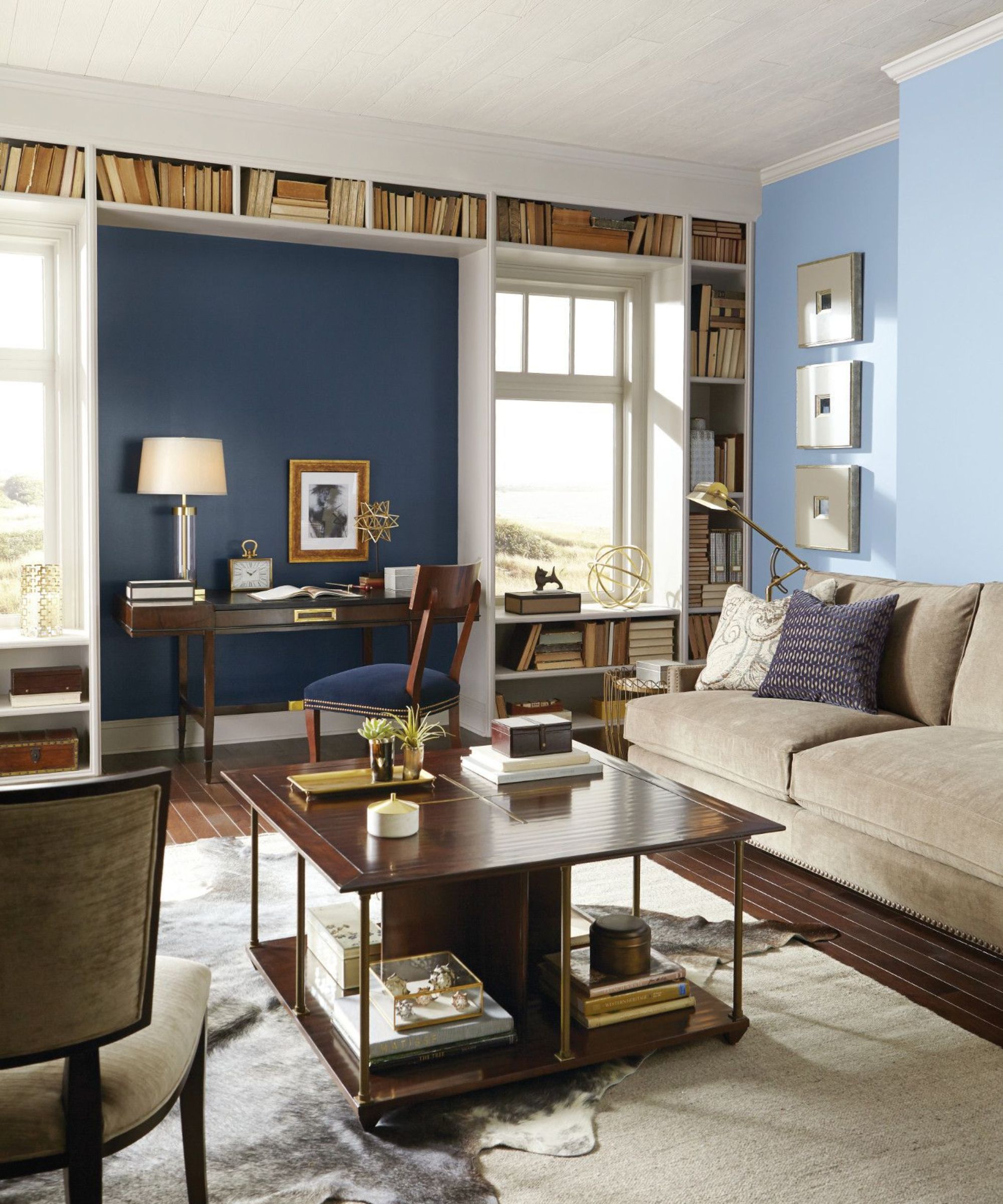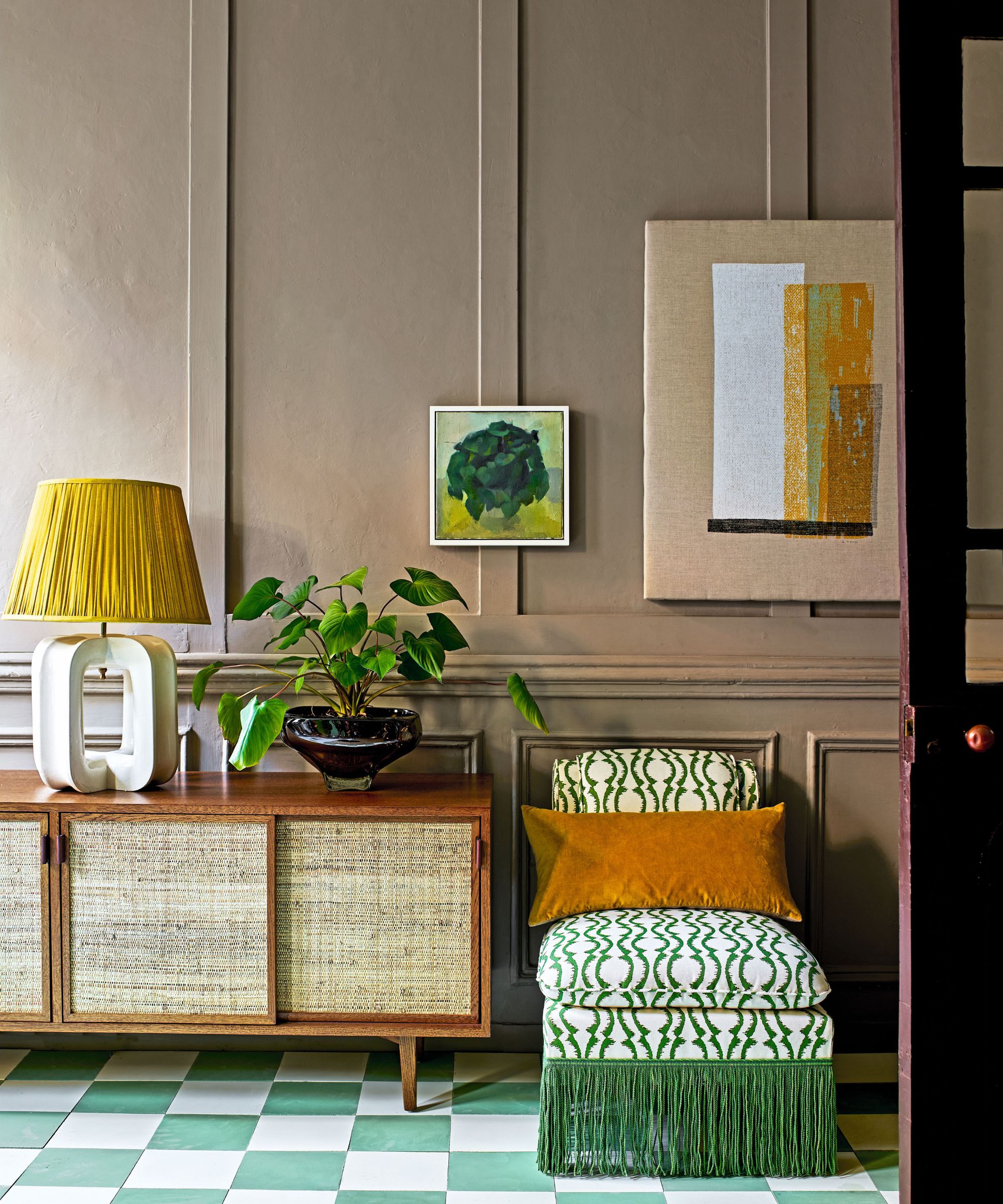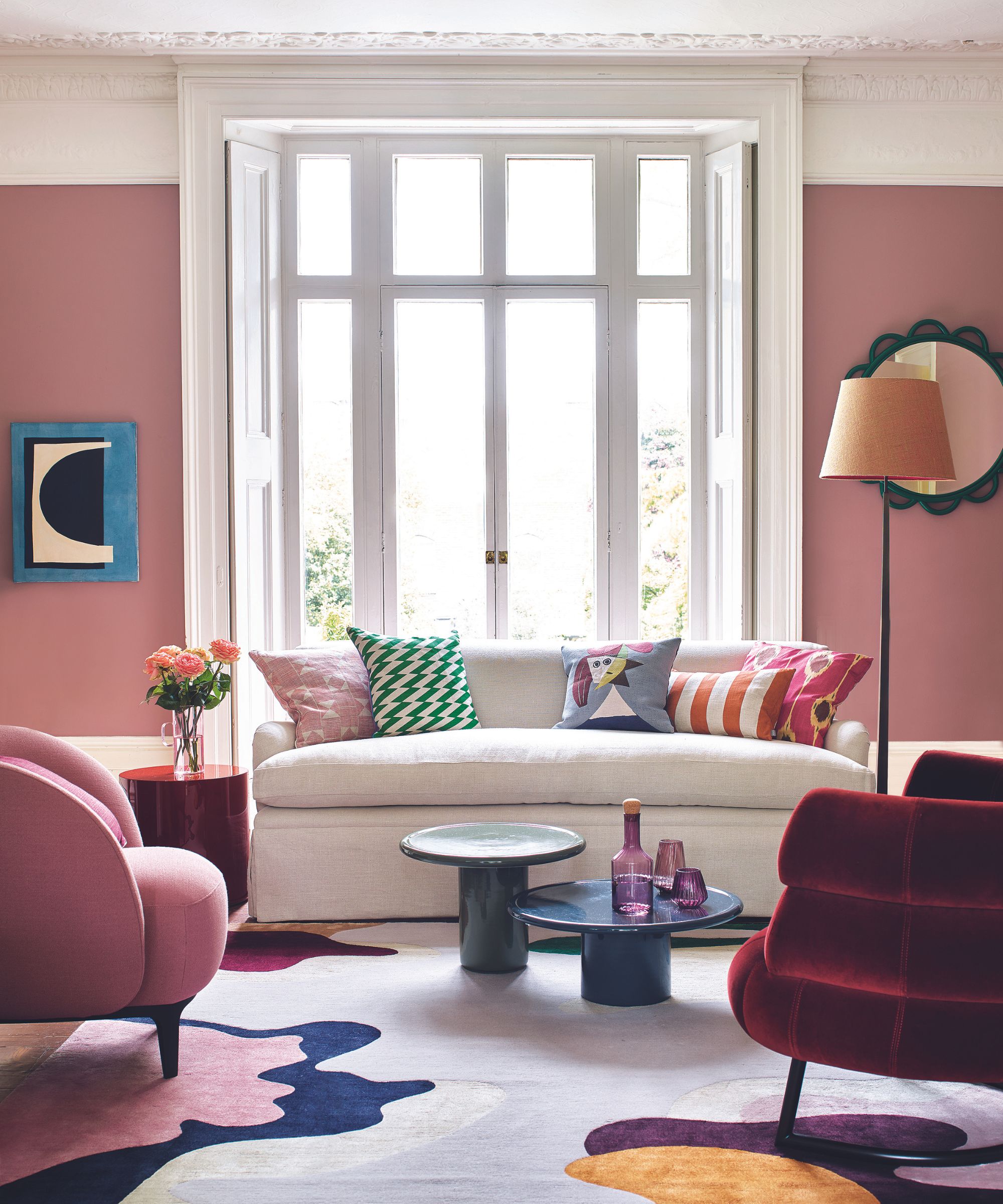6 rules you should always follow when designing a soothing living room, according to a design psychologist
Amber Dunford, style director and design psychologist, shares her best advice for curating a living room that puts your mind at ease


The way your home makes you feel is undeniably important. Whether you spend loads of time at home or simply retreat to your space at the end of long days, it's important to curate a place that puts your mind at ease.
Amber Dunford, style director and design psychologist, has built a career around doing just that. With degrees in interior design and psychology, she now offers personalized design psychology lessons for designers and homeowners alike. And while every space impacts your mood, many of us spend most of our waking hours in the living room – that's why Amber agrees it's one of the most important places to get the design scheme right.
To get her top comforting, personalized living room ideas, we spoke with Amber about how she styles a space. These are the six rules she says you should always follow when designing a living room with well-being in mind.

Your home should feel like a sanctuary, and it all starts with the design scheme. Paying attention to how each element of your home could be softer on the senses might require a bit more thought than picking out pretty fabrics, but the approach has an incredible impact when all's said and done. Amber says that focusing on what feeling you'd like to get from the space when it's finished is a perfect place to start.
'Ask yourself how you want it to feel and think about spaces where this emotion has been evoked for you. Are there elements from those space you can bring into your home and work with? Maybe it’s an earthy plaster wall to replicate a sandy beach or a deep green color monochromatic palette reminiscent of the woods,' she says.

Over the course of her career, Amber Dunford has worked as an interior stylist, environmental designer, visual merchandiser, art director and clinical psychotherapist. She is currently the style director for Bed Bath & Beyond and Overstock.com, and offers personalized design psychology sessions to designers and homeowners.
5 design psychologist-approved rules for the living room
'Living rooms are aptly named, as we often spend a great deal of our time in that particular area of the home. With that in mind, I believe they are one of the most important spaces when it comes to design – they often need to suit activities like lounging, work, hosting and quiet time, which are most likely accompanied by different moods,' says Amber.
Because it's such an important space to get right, Amber has compiled a list of her top six tips for making sure your living room is relaxing and calm – plus feeling just like you. This is what she had to say.
Design expertise in your inbox – from inspiring decorating ideas and beautiful celebrity homes to practical gardening advice and shopping round-ups.
1. Opt for layered lighting

Amber's first tip has to do with the living room lighting scheme, and she says a layered layout is key. Because 'overhead lighting can feel a bit clinical at times,' she says it's vital to think through the levels of light that exist (or could exist) throughout your home.
And in the living room, finding these layers ensures a cozy, welcoming atmosphere: 'Layered lighting adds more depth and warmth to spaces by evenly distributing light throughout your home,' says Amber.
She also suggests familiarizing yourself with the Kelvin scale, which is used to measure the warmth of light bulbs. Sticking with 'warmer Kelvin bulbs around 2700' is an easy way to bring the outdoors in and feel at ease in your space.
'This temperature of lighting best replicates lighting found in nature and humans tend to feel more at ease in this style of lighting. When multiple temperature bulbs are used it can feel psychologically jarring, so it’s important to stick with one throughout,' she says.
To put the layered look into practice, Amber suggests a straightforward formula: 'In a living room, opt for a pendant or chandelier in addition to your recessed lights. This helps define the main territory by creating a visual anchor from above. It also gives you an opportunity to bring in a design element that helps set the tone of the room,' she says.
On the walls, she advises sconces for above artwork, on either side of a fireplace or down a hallway to 'warm up the walls, make artwork feel more high end and highlight architecture.' For the lower levels, table lamps and floor lamps 'provide a nice glow to seating areas and are functional when paired with a cozy reading chair.'
2. Bring in lush, 'touchable' textures

'Humans are tactile creatures and often use textures to self-regulate, so it’s nice to include a variety of textures in your design. Think a velvet sofa paired with leather side chairs, a boucle occasional ottoman and a nubby woven throw. This creates visual depth and allows people to position themselves near textures that best suit their mood,' says Amber.
Any design element can introduce lush texture into your space, so get creative with the furniture and decor you choose. Amber says that even artwork on canvas, 'a fabric or rope wall hanging' or textured wallpaper can add eye-catching depth and interest to the living room.
Think about the message you want to send through your space, and design accordingly – do you want your space to feel calm and laid-back, or bright and inspiring? Using texture in interior design can help deliver on a wide variety of emotions.
'Working with a variety of materials offers the flexibility to create a visual story with textures according to seasons, allowing you to conjure different moods throughout the year. In fall, for example, you might layer in fur throws, wool pillows, and sweater knits through textiles conjuring a sense of coziness. While in summer months, you might want to opt for linen accents, cotton pillows, and airy window treatments that speak to the easy lighthearted vibe of summer,' says Amber.
3. Offer a variety of seating

'This rule is a nice one to consider if you are someone who enjoys hosting and are interested in working with living room furniture that accommodates both introvert and extrovert personality types. This is also something to think about if you share this space with mixed personality types who will be utilizing the space together,' says Amber.
Cater to your guests (and your family) by providing plentiful seating throughout the living room, and mixing up the type of seating on offer. Sofas are well and good (and you'll rarely find a living room without one), but bringing a variety of additional seating into the mix makes your living room a safe space for everyone.
'Sofas are obviously a staple piece for a living room and a great shared seating option, especially for extroverts who tend to enjoy the closeness in proximity they offer to others. However, sofa seating can be a bit anxiety provoking for introverts who prefer individual seating options like an occasional chair, ottoman or chaise lounge,' Amber adds.
Plus, this approach means that you can rearrange and customize your living room seating at a moment's notice. If you're feeling more collaborative, pull the furniture together into a central hub. If you need an evening to yourself but still need to share the space, opt for a more disparate layout and protect your peace.
4. Look for furniture with visible wood grain

'This next rule plays into biophilic design, which is essentially our innate connection to nature and our desire to bring nature into our homes. When we view things found in nature, we often have a decrease in stress levels and tend to feel more relaxed overall,' says Amber.
Embracing the natural grain of wood in furniture, flooring and accessories is an easy and accessible way to introduce a bit of natural appeal into your home. Amber suggests opting for larger furniture pieces, like coffee tables and side tables, that feature natural wood detailing or seeking out a stain that will accentuate wooden furniture you already own.
'Wood grain is an element derived from nature that has been shown to elicit a reduction in anxiety and stress when viewed. This concept makes a nice case for bringing visible wood grain into your living room, especially if your goal is to create a serene and calming space for yourself and your guests,' says Amber.
5. Make the room feel like you

Personalizing your space is one of the easiest – and most familiar – ways to spruce up your space. And when designing with well-being at the top of your priority list, making your home feel more like you is even more important. Amber says that the living room is 'one of [her] favorite places to include elements that feel like conversation starters' because it's often where friends, families and guests come to gather.
'Conversation starters can be a unique sculpture or object found during travels, an interesting art piece by a local artist, or a family heirloom on display. Essentially, these objects should have a story that you are comfortable sharing with others and even better, if they offer a nice insight into who you are as a person. These items can say something about your personality, your values, or show your reverence for specific crafts, cultures, or places in the world,' she says.
6. Bring in the vintage

Amber's final tip for successful living room design schemes is to decorate with vintage furniture and decor, as these items add visual interest and personality to your space.
'I find there is something special when a space includes pieces that do not feel of this era, as though they were purchased from a store or just an oddball piece that nicely complements the room. A vintage chair or lighting piece in an otherwise curated room adds a sense of warmth and history,' says Amber.
'This is especially important to consider when you are working with newer homes that may not inherently have those storied architectural elements. The right amount of imperfect shapes or weathered pieces offer an easygoing energy to the living room that allows it to feel approachable and not overly formal,' she continues.
A living room design mistake to avoid
A vast array of considered design elements can contribute positively to a living space, but Amber says there's one approach she'd avoid at all costs: 'designing in head-to-toe trend.' And with 2024 proving the year of the anti-trend so far, we can't help but agree she's onto something.
'This can date your space and make it harder to evolve over time. Instead, design from a place that feels personal, and tap into what makes you happy and feel most balanced. For some people a dark and moody home feels oppressive, but for others it offers a quiet respite and a much-needed contrast to the harshly lit buildings we spend a lot of our time in,' she says.
Pay attention to interiors that make you feel calm, at ease, and most like yourself, and channel them in your own home. Out of all the spaces you dwell in, your home is the only one you can control – take advantage of the opportunities ahead of you and design with mental wellness front of mind.
With these design psychologist-backed tips for a better living room design, you're well on your way to a cool and calming home base. Look to the outdoors, express your full self and make room for relaxation, and you'll be left with a home you never want to leave.

Abby was the Interior Design News Editor at Homes & Gardens and is now studying for her Master's degree in Journalism at City University, London. Prior to joining our team, she worked with Better Homes & Gardens, where she wrote and edited content about home decor, gardening tips, food news, and more. She studied Journalism and English Literature at New York University and moved to London to pursue her love of writing in 2023.


